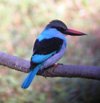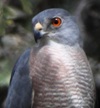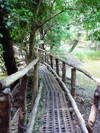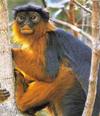Abuko
Nature Reserve,
Africa,
was the
Gambia's first
reserve and is located in the Western Region
(WR), (
geographical coordinates: 13.41°N, 16.65°W). Part of it was
accorded a form of 'protected
status' back in 1916 when the source of the Lamin
(
Bolon) Stream was fenced to form a water collection point.
In 1967 a local
Gambian man called Kalilu requested the then

acting
wildlife
officer,
Eddie Brewer
(OBE), to shoot a leopard that had been killing their
pigs which had been feeding there illegally. When he visited
the spot with his daughter, Stella, they saw an amazing richness of
Gambian
wildlife and flora and realised the conservation importance of the stream
running through Abuko. They made a request to the
government to protect it
which was promptly approved when it was officially declared a nature
reserve
in March 1968.

Abuko's size was
extended from 188 to 259 acres in 1978 and enclosed in a 2.5 metre
fence with the help of the WWF. It is among six protected
wildlife
management parks and covers an area of 105 hectares (roughly 2 sq.
km). The park is
rectangular in shape with a surrounding narrow
strip around its boundaries acting as an extra buffer zone. Later in
its development
2,000 malina trees were planted to act as an extra barrier against
encroachment by locals.
Today,
Abuko is the Gambia's most visited tourist
attraction receiving
approximately 33,000 visitors per year. One interesting fact is that
it is the nearest tropical forest to Europe.
 Habitats:
Habitats:The evergreen forest
gallery follows the course of the

Lamin
Stream and covers approximately 1/3 its total area. Efforts are being
concentrated on maintaining the crooked bush trails, bird photo hides,
the animal orphanage as well as the boundary to prevent
encroachment by people and cattle. There are a number of small pools
at the
bottom end or the reserve with the biggest being called the Bamboo
Pool. In and
around the freshwater pond is the ideal location to spot crocodiles
and birds. Its location is within easy reach by
taxi from any of
the main
coastal holiday resorts. It is an ideal first stop for
birdwatchers
and animal enthusiasts as well as tourist in general. There are
designated guides on site to help you
locate animals and birds while on the forest trail and a tip is always
appreciated though not mandatory.
 Park Management:
Park Management:

The
conservation of the animals and plants is managed by the
Department of
Parks and Wildlife Management who are based at the
Darwin Field
Station for Biodiversity. There main aim is to protect the location and prevent
species extinction and helps to fund
its activities by charging day trippers an
entrance fee.
 Flora:
Flora:

Fifty
types of mature
tropical trees have been recorded in the protected area.
Abuko's main geographic features are several kinds of habitat
starting with thick tropical canopy which after 50 to 100m
from the
stream gives way to Guinean savanna. Probably due to increased
borehole
water removal the
natural habitat has seen the gradual disappearance of mature tropical trees of
which the most obvious is the A. Procera and the E.
Guineensis. For non experts the trees are labelled.
 Avi Fauna:
Avi Fauna:It has been estimated
that there are over 290 bird

species living within the forest gallery. Among the birds are Pied Kingfishers,
African paradise flycatcher, Willow
Warblers, waxbills, western bluebill , manikins, doves, lily trotters,
giant kingfisher C. maxima, palm nut vultures, hammerkop Scopus
umbretta, Ceryle rudis, grey headed bristle bill, white crowned robin
chat, grey backed camaroptera, lanner falcon, pygmy kingfisher, violet
turacoes, African thrush, fork tailed drongo, black Herons, squacco
heron, oriole warbler, Black crake, red bellied fly catchers, little
greenbul,
yellow breasted apalis, cattle egrets, Abyssinian roller, purple
glossy starling & the Green Touraco.
 Fauna:
Fauna:
There are 4 primate species: Vervet monkey, Red

Colobus monkey, red Patas and Bush Babies.
The other mammalian types include the Grimms Duiker, Ground
Squirrel, Savannah Antelopes, Bushbuck Colobus badius, Tragelaphus, Brush Tailed Porcupine,
Viverra civetta, sitatunga T. spekei, Erythrocebus patas, Mungos
gambianus, serval Felis, Heliosciurus gambianus, Thryonomys
swinderianus, Galago senegalensis, Actophilornis Africana, Tauraco
Persa, Gastropyxis smaragdina Crocodylus niloticus, Xerus erythropus,
Cercopithecus aethiops, Palm civet Nandinia binotata and several
types of rodent including the Cane Rat.
Threats to the monkeys of The Gambia:
E. D. Starin 1
a1 Department of Anthropology, City University of New York, Graduate
Center, 33 West 42nd Street, New York City, NY, USA. Published
online by Cambridge University Press 24 Apr 2009.
"Abstract
There are five, perhaps only four, monkey species in The Gambia and
all are under threat. The main problems are habitat destruction,
hunting of crop raiders and illegal capture for medical research.
The information presented here was collected during a long-term
study from March 1978 to September 1983 on the socio-ecology of the
red colobus monkey in the Abuko Nature Reserve. Further information
was collected during brief periods between February 1985 and April
1989 on the presence of monkeys in the forest parks. It is not
systematic nor extensive, but it indicates clearly that action is
needed if monkeys are to remain as part of the country's wildlife.
The most pressing need is for survey work to supply the information
needed to work out a conservation plan."
Among the
reptiles at the park are the Monitor Lizard, Nile
Crocodile, West African crocodile, Dwarf Crocodile, Spitting Cobra,
black cobra, python Python sebae, Puff Adders, emerald snake & Green
Mamba though it is rare to see.
There are also numerous
butterflies and moths such as the Saturnis.

While
there you can also visit the
Animal Orphanage
which was set up in 1997 as a rehabilitation centre by the DPWM. It
cares for parrots, hyenas as well as various kinds of Monkeys
including Chimpanzees. Also located on the reserve is the
Darwin Field Station which is a research centre focused on
maintaining The Gambia's biodiversity. There is also an exhibition,
the Abuko Conservation Education Centre and refreshments area which
are concentrated around the animal orphanage.
 Nature Trail:
Nature Trail:

Starting
your trek you will first come across loose
leafed Guinea savanna and you will see trunks covered in mud deposited by tree ants. The
trail later drops towards the main Bamboo Pool which is partly covered
in water-lilies and fringed by large palms. You will then come across
a wooden foot bridge which spans a small swampy stream and goes past
the first bird hide and towards the visitor's centre. This building
was built in 1970 as a rest house for visitors.
If you make your way
up to the observation platform it is possible to get a birds-eye-view
of large lizards, numerous feathered avians and Dwarf or Nile
Crocodiles (particularly in the mornings when they come out of the
water to sunbath).
From this point you follow the nature trail which
leads you to thick, dark, lush vegetation. As you turn left you will see the
first glimmering of open bright savanna which is soon interrupted by
more thick jungle which is interspersed at ground level with huge
trunks and large root systems. If you look carefully you can see
numerous ground squirrels, brightly coloured beetles, vervet monkeys,

soldier ants, birds and butterflies. As you continue along the cooked
path leading along the southeast you will arrive at an enclosure
housing some vultures and hyenas at the
Animal Orphanage.
There is a
kiosk here where you can enjoy some refreshments. In the next
enclosure you can observe Crowned cranes, baboons and bushbuck and
next to them you will come across a few lions. From this area there is
a path that veers off towards the exit if you are feeling a little
tired by this time.
A walk along the trail can take you a
couple of hours though there is a short-cut route.

Contacts
details:
Department of Parks & Wildlife
Management.
Tel no: +220 4375888
4376972
Fax: 4392179
Email:
wildlife@gamtel.gm
 Travel Information:
Travel Information:

If you are not with a
tour operator you can pick up a cheap bush
taxi
from
Westfield Junction that is going to Lamin Village on the main
Serrekunda to
Brikama road and ask to be
let off at the front entrance. The best time to visit for
birdwatchers
is early morning or late afternoon as you can avoid the tourist crowds
who tend to come over in the late morning or early afternoon.
Wear thick sturdy boots, use mosquito
repellent & bring along
some refreshments if you plan to stay long.
An entrance fee is payable. With a
tour operator
it could cost around D150 for a day trip. If you use a tour operator
then the cost could be up to £30 for a full guided tour as well as
hotel transfers. Refreshments are available should you wish to spend
the day there.
http://www.accessgambia.com/information/abuko-nature-reserve.html






 Humans
cause most invasive species introductions. Invasives are carried in or
on animals, vehicles, ships, commercial goods, produce and even
clothing. Along the Clearwater, Snake and Columbia Rivers, there have
been several introduced invasive species in the past few years, with the
threat of further infestation by new species in the near future.
Humans
cause most invasive species introductions. Invasives are carried in or
on animals, vehicles, ships, commercial goods, produce and even
clothing. Along the Clearwater, Snake and Columbia Rivers, there have
been several introduced invasive species in the past few years, with the
threat of further infestation by new species in the near future. Several threatened and
Several threatened and 


































 Contacts
details:
Contacts
details: